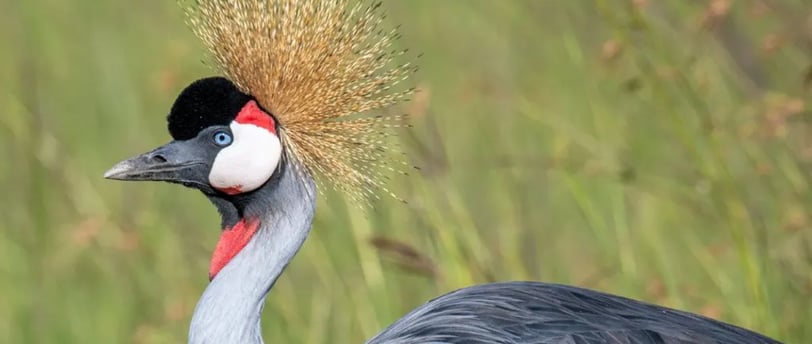Reviving Uganda's Wetlands: A Community Effort to Save the Cranes
Ugandas Crested cranes go instinct
LOCAL NEWSLATESTWORLD NEWS
2/16/20254 min read


The Importance of Wetlands and Crane Conservation
Wetlands serve as essential ecosystems that contribute significantly to the overall health of the environment. These areas, characterized by the presence of water, whether seasonal or permanent, provide critical habitats for a diverse range of species. In Uganda, wetlands play a pivotal role in maintaining biodiversity, serving as breeding and feeding grounds for numerous flora and fauna, including the iconic cranes. These majestic birds rely on wetlands for sustenance and reproduction, making their conservation intricately linked to the health of these ecosystems.
Furthermore, wetlands are crucial for water purification, acting as natural filters that remove pollutants and excess nutrients from water before it enters larger water bodies. This purification process not only benefits aquatic life but also supports agriculture and drinking water supplies for local communities. By enhancing water quality, wetlands contribute to the overall resilience of the ecosystem, which is vital for the survival of various species, including Uganda’s cranes.
Another significant function of wetlands is their ability to manage floodwaters. During heavy rainfall, these areas can absorb excess water, mitigating the impacts of flooding on surrounding communities. This natural flood control mechanism is critical for protecting agricultural lands and ensuring the security of livelihoods dependent on farming. Moreover, the presence of healthy wetlands can promote tourism, as many people are attracted to the unique wildlife, including the cranes that inhabit these areas.
Finally, cranes hold cultural and economic significance for local communities, being a symbol of pride and identity. Their graceful behavior and striking appearance contribute to local folklore and traditions. By valuing and conserving both wetlands and cranes, a harmonious relationship can be fostered, ensuring the sustainability of the environment and the well-being of the communities that depend on these natural resources. Efforts to preserve these ecosystems must, therefore, be prioritized to safeguard Uganda’s rich biodiversity.
Government Initiatives and Community Involvement
The Ugandan government has taken significant strides towards wetland conservation, with a particular emphasis on mobilizing community support for the protection of these critical ecosystems. In a landmark initiative, President Yoweri Museveni has championed the cause of wetlands, declaring 2025 as the designated year of wetland conservation. This proclamation serves to heighten awareness about the crucial role wetlands play in biodiversity, climate regulation, and the well-being of local communities. It marks a critical step in galvanizing both governmental and public action to address the ongoing degradation of these valuable areas.
To complement this initiative, the Ugandan government has committed to enforcing stricter laws aimed at preventing encroachment on wetland areas. This enforcement is crucial, as illegal activities such as farming, construction, and pollution have led to significant loss of wetland habitats. By imposing heavy penalties and promoting awareness campaigns, the government aims to protect these vital ecosystems from further destruction. Furthermore, the presence of the local authorities in monitoring these areas fosters a more integrated approach to conservation that encourages community participation.
In conjunction with governmental efforts, various conservationist groups are actively engaging local communities in wetland restoration projects. These organizations believe in the power of grassroots activism, fostering a sense of ownership and responsibility among residents. Community workshops, educational programs, and hands-on restoration activities not only empower individuals but also enhance their understanding of the ecological importance of wetlands. By working collaboratively, residents are more likely to adopt sustainable practices, thus ensuring the health and vitality of these ecosystems for future generations. The synergy between governmental initiatives and community involvement is pivotal in the effort to revive Uganda’s wetlands and protect the endangered cranes that depend on these habitats.
Challenges in Crane Conservation and Wetland Restoration
Conservation efforts for Uganda's cranes and wetlands are increasingly challenged by various obstacles that threaten both the species and their natural habitats. One of the most pressing issues is illegal encroachment on wetland areas, primarily driven by agricultural expansion and urban development. As land becomes a premium resource, more individuals and businesses are venturing into wetlands, resulting in habitat loss that directly endangers crane populations. Conservationists, including Mr. Muheebwa, emphasize that while some progress has been made in raising awareness and advocating for sustainable land use, the encroachment persists, complicating restoration efforts.
Another significant challenge is climate change, which exacerbates existing pressures on wetlands. Fluctuating weather patterns lead to prolonged droughts and heavy rainfall, affecting the hydrology crucial for crane breeding and feeding. Wetlands act as natural buffers against extreme weather, but when their capacity is compromised, the delicate balance necessary for crane survival is disrupted. These environmental changes hinder the success of restoration initiatives, prompting conservationists to adopt a more holistic approach to managing wetlands, which includes climate resilience strategies.
Additionally, habitat degradation due to pollution from agricultural runoff and industrial activities further complicates the conservation landscape. Contaminants not only diminish water quality but also affect the food sources available to crane populations, making it increasingly difficult for them to thrive. Conservationists are actively calling for stricter regulations and community engagement to mitigate these effects, yet challenges remain daunting. Despite acknowledging the slowly improving situation, the number of cranes in Uganda continues to be critically low, necessitating sustained effort and innovative solutions to overcome these barriers effectively.
Future Strategies for Sustainable Wetland Management
As efforts to conserve Uganda's wetlands and protect its iconic crane species progress, it is essential to explore potential strategies for sustainable wetland management. These strategies not only aim to enhance crane conservation but also foster community involvement and safeguard the health of wetland ecosystems. A promising approach involves the integration of local custodians, who have been recruited by the International Crane Foundation (ICF) to monitor breeding grounds. These custodians can provide invaluable insights into the local environment while ensuring that the breeding habitats are preserved and protected from detrimental activities.
The Uganda Wildlife Authority (UWA) plays a crucial role in the education and enforcement aspects of these strategies. Training local communities on the ecological significance of wetlands, along with the importance of cranes, will empower individuals to become active participants in conservation efforts. This educational initiative can help to mitigate conflicts that arise from human-wildlife interactions and promote sustainable land-use practices. Furthermore, consistent enforcement of wildlife protection regulations is vital to ensuring that conservation measures are respected and that potential threats to both the cranes and their wetland habitats are addressed promptly.
Another key factor in the future management of wetlands is community engagement. By actively involving local communities in conservation efforts, there is a greater likelihood of developing stewardship that will endure over time. This could be achieved through various means, such as organizing awareness campaigns, promoting ecotourism, and providing platforms for local voices to be heard in decision-making processes. Additionally, international support from conservation organizations and partners can further strengthen these initiatives. Collaborating with global entities can bring in vital resources, expertise, and innovative solutions necessary for a comprehensive and sustainable approach to wetland management that safeguards cranes and their environments.
